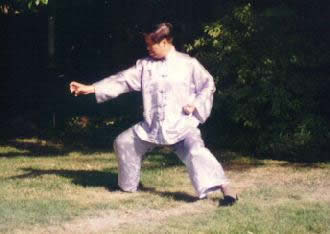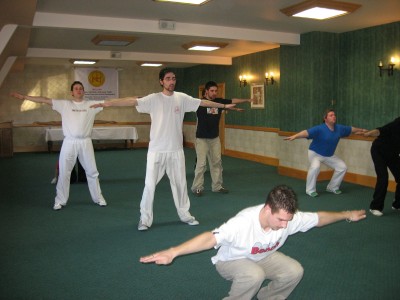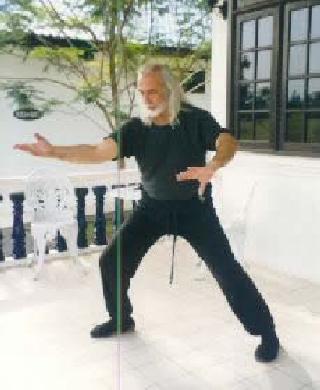January 2000 (Part 1)
SELECTION OF QUESTIONS AND ANSWERS

Sifu Wong demonstrating the Tiger-Claw
Question 1
I have successfully induced chi flow and I feel very fresh after about 15 minutes of this flow. However, why do most masters discourage this practice?
— Lim, Malaysia
Answer
It is helpful to note that now I usually refer to “induced chi flow” as “self-manifested chi movement”. I change the term because, as one of my senior students correctly pointed out to me, chi is induced to flow in all chi kung exercises. Hence, “self-manifested chi movement” is a more appropriate term; it is also a more exact translation of the Chinese term for this type of exercises, namely “zi fa dong gong”.
Most masters discourage self-manifested chi movement because while they are expert in their styles of chi kung, they are not trained in self-manifested chi movement. My rough estimation is that most masters are trained in dynamic patterns (or dao yin chi kung). Among the most powerful masters, most of them (their number is actually small as they form the apex of the masters) are trained either in quiescent breathing (like the Small Universe) or in zhan zhuang (like the Three-Circle Stance).
This does not mean that self-manifested chi movement is less useful than the other three classes of chi kung exercises. Each class has its own special strong points. Self-manifested chi movement is particularly useful for helping people overcome illness, whereas zhan zhuang, which is particularly useful for developing internal force, may seriously aggravate a person's illness if performed incorrectly.
On the other hand, instructors who merely teach chi kung external forms but who may be mistaken as masters, discourage self-manifested chi movement because they do not know how to handle the situation if their students get out of control.
Question 2
When can this practice be dangerous to the person?
Answer
It can be dangerous if the person gets out of control, which may happen if he is not properly trained. It will be very dangerous if the person has heart problems.
Question 3
Is this flow internal (i.e. in the organs) or external (i.e. only at the limbs)?
Answer
For convenience, the flow can be classified at five levels — skin, flesh, meridians, bones and organs.
Question 4
Can this practice lead to internal injury of the organs?
Answer
Yes, if it is incorrectly performed. If it is performed correctly it is excellent for overcoming illness, including internal injuries and diseases of organs.
Question 5
Is this practice safe only when the movements are gentle?
Answer
When correctly performed, it is safe irrespective of the types of movements. Indeed, those who have difficult health problems often manifest very interesting and vigorous movements, sometimes accompanied by funny noises.
Nevertheless, if the practitioner has not acquired sufficient skill to perform this class of chi kung, it is advisable to have gentle movements.Question 6
Can I practise this for longer periods e.g. half hour, one hour?
Answer
Yes, if you are competent or supervised by a master. If you are on your own, especially when you are new to this type of exercise, it is not advisable to practise longer than 10 minutes.
Question 7
What are the side effects if any of this practice?
Answer
You may become nervous or anxious for no apparent reasons, aggravate your illness, distort your hormonal production, and injure your organs.
Question 8
When the movements become violent, can this lead to internal injury?
Answer
No, if it is performed correctly; yes, if it is incorrect.

What makes any exercise chi kung is not its form but how it is being performed. "Three-Level to the Ground" shown above, for example, is an excellent chi kung exercise for strengthening the heart as well as the legs, but it is usually performed as physical leg-stretching exercise.
Question 9
Most masters prefer to accumulate and cultivate chi at the dan tien rather than allow it to free flow without control. Does this go against this practice?
Answer
Your statement is invalid, or inaccurate. All chi kung — real chi kung — has two dimensions, namely chi flow and chi accumulation. In Chinese they are called xing qi and yang qi. Depending on different chi kung types, individual needs and other factors, practitioners may emphasize one dimenion over the other.
For example, chi flow is emphasized in self-manifested chi movement, but before the practitioner completes his exercise he accumulates his chi at his dan tian. Chi accumulation is emphasized in abdominal breathing, but much chi flow is also involved as the practitioner transports tapped energy from the cosmos to his dan tian.
Secondly, control is essential in all types of chi kung. In self-manifested chi movement, the practitioner purposely allows his chi to flow freely, but he is in full control all the time. Whenever he wishes to redirect, slow down or stop his flow, he can do so at will.
Perhaps what you mean is that there are more masters as well as students who practise quiescent types of chi kung like abdominal breathing and zhan zhuang than those who practise self-manifested chi movement. One important reason for this situation is that only a real master can teach self-manifested chi movement, whereas almost anyone who has learnt abdominal breathing, zhan zhaung and most other types of chi kung, even from books and videos, can teach them to other people — often adversely.
Question 10
Most masters prefer to control the flow of chi by will rather than allow it to free flow. What are your comments?
Answer
Your statement is not true. Even masters who do not practise self-manifested chi movement, allow their chi to free flow. “Be natural” is an important tenet in all chi kung training. This tenet means that the practitioner purposely does not use his will to control his chi, but allow his chi to flow naturally.
In zhan zhuang, for example, the practioner lets his chi flow naturally, rather than direct it to flow in certain ways. On the other hand, in self-manifested chi movement a practitioner may purposely use his will to control his flow of chi.
Question 11
I am a teacher at a senor citizens' home. After reading your book, the Art of Chi Kung, I decided to try it myself. I tried both the Moon and one of the other momvements to induce chi. I found nothing happening. The only thing that happened was that I started to fall forward as if I was loosing my balance. After two or three times like this I finally started to sway. I am not sure if I consciously started to sway or it was from the movement.
— Larry, USA
Answer
It is difficult to tell from an e-mail description whether your reaction was due to induced chi flow, or due to your loss of balance, or due to your conscious attempt to sway. But even if your sway was due to chi flow, it did not necessarily mean you were practising chi kung. Chi kung is not merely swaying.
Question 12
I decided to try it in my class of 8. I had the class close their eyes and I said to them if they started to sway they were to go with it (in accordance with the instructions in your book). Out of the 8 only one started to sway. Is this sway something that is consciously brought on, or is it just supposed to happen?
Answer
Yours is a typical example of how little knowledge and respect many Westerners have of chi kung. Many Westerners (and modern Easterners) think that they can just read from a book, try some exercises on their own, and then start teaching others. Especially if they are unemployed, they may continue teaching so-called chi kung for a living, and after a few years they may call themselves, or others may call them, masters.
You have done yourself, your students and the art a great dis-service. You have not learnt or practised chi kung properly, yet you have started to teach others. This is unprofessional. You do not understand the effect chi flow has on your students, and despite my warning in my books that incorrect practice may lead to serious harmful effects, you have decided to try it on others. This is unehical.
The sway may or may not be brought on consciously. Whether it should or should not happen, depends on numerous factors. But swaying itself is not chi kung.
Question 13
Also, I am very interested in your intensive courses on healing incurable diseases. However, financially it is impossible for me to travel to Malaysia. Are you planning by any chance to bring your classes to the United States, or can someone learn what you teach through a video? And do you have such videos available?
Answer
Merely being interested is far from sufficient. Before you think of becoming a healer or a teacher, be a student first. The large number of people, especially in the West, who imagine that they can become healers or masters, without having to make the minimum effort to learn and practise the art first, really amazes me.
I sometimes teach in the United States.
People may learn external forms from videos, but these are actually not what I teach in my chi kung or kungfu classes. What I actually teach in my chi kung classes are skills to manage energy, and in my kungfu classes skills for combat efficiency, internal force development and spiritual cultivation.
Anyone who thinks that such skills can be learnt via videos do not know what chi kung or kungfu really is. Hence, I have not produced videos for the purpose of self-instruction.Question 14
I also had a lady whose heart started to beat fast after the exercises in your book. Does this have any significance, as she was starting to get a little nervous?
Answer
Luckily she did not collapse. Your unprofessional teaching could have killed her.
The heart starting to beat fast during a chi kung exercise may or may not be good. It depends on various factors. In my teachng, many students with serious heart problems had their heart beating very fast during their practice under my supervision. I had to be extremely careful, and observe them and their reactions closely.
On one occasion I was about to ask a student to slow down and stop when she exclaimed how wonderful she felt. She as well as the other students soon recovered from their illness. But a less experienced instructor might have killed them in similar situatons.Teaching chi kung to those with heart problems must be done by a master. Even trained instructors may not be competent enough to handle students with serious heart problems. In such cases, it is best for the instructors not to teach these students.
Question 15
In your book “The Art of Shaolin Kung Fu”, I have read the section on practicing One Finger Zen. When you breathe in, how do you gather the chi?
— Chris, Australia
Answer
“One Finger Shooting Zen” should be learnt from a master. You are likely to miss its essence if you learn from a book.
Chi can be gathered in many ways; the main ways are using your mind and your breathing. If you ask a master how does he tap chi, he will honestly answer “I just tap chi.” It is like asking someone how does he eat or walk.Question 16
I'm not sure what you mean by making the “shsss...” sound from the kidneys. I've done dan tien breathing, with vibrations in the chest (the “yaaa” sound), but not from the kidneys.
Answer
I actually mean what I say, i.e. making the “shss...” sound from the kidneys. It is the same as saying breathing at your dan tian, or making the "yaaa" sound from your lungs.
Question 17
Is the “it” part of the “her-it” sound caused by closing the teeth suddenly (not fully closed) with the tongue blocking off the noise by pressing against the pallette? I have done that breathing in various Iron Shirt practices.
Answer
No, the teeth and the lips should be kept open. If you close them you may cause back-flow of energy to your heart or lungs, and this can be harmful.
Do not worry about the tongue, but let the sound come from your abdomen, not your throat as it often happens with novices.
Master Leslie James Reed, Director of the International Taijiquan & Shaolin Wushu Association, going into some beautiful kungfu movements spontaneously during a self-manifested chi movement exercise while taking an intensive chi kung course with Sifu Wong in Malaysia
Question 18
In the tiger claw movement, does one make a full rotation with the hand before the hand goes to the knee? Or does that rotation include the hand going to the knee? Again, do you recover your hand back to your side in a straight line, or do you continue the curve?
Answer
The points you have raised are not important. What is important is that you can generate internal force to your fingers, and this is done well with your lungs vibrating.
Question 19
When making the “ha” sound to relax, to make this sound pure and loud, I find my abdomen tensing a lot, but briefly. Is this relaxing done in the right way? Is it a short, loud sound?
Answer
No, what you have done may be harmful. The “ha...a...a...a” sound should be soft, long and gentle; not a short, loud “ha”.
Question 20
I have diabetes (type one, juvenile), and I am wondering if One Finger Zen would be good for my health. With this condition in mind, I have heard varying reports on what sorts of qigong training are good or bad for diabetes and kidney chi.
Answer
It is not what you do, but how you do it, that is important. In other words, the same One Finger Shooting Zen movement can be beneficial or injurious depending on whether you have practised it correctly or wrongly.
The way you have performed One Finger Shooting Zen, as gathered from your discription, is likely to agravate your diabetes or cause other health problems. This is one main reason why masters have always advised that internal arts, like One Finger Shooting Zen, must be learnt personally from masters. The trouble today is that people not only learn internal arts from books or videos, they rush to teach others even before they know what internal arts are.
In fact if you have practised genuine Shaolin Kungfu correctly, irrespectively of whether you have performed One Finger Shooting Zen, you should have overcome your diabetes or any other health problems. Every movment of genuine kungfu or chi kung is a training of energy and mind.
This means that if you have practised genuine kungfu or chi kung for three years, you have trained your energy and mind for three years. It is reasonable to say that if one is still sickly or weak after a few years of kungfu or chi kung practice, then either his art is questionable or his training is faulty.
